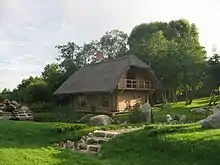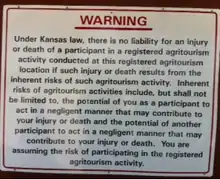Agritourism
Agritourism or agrotourism involves any agriculturally based operation or activity that brings visitors to a farm or ranch.
_06.jpg.webp)


Types
A 2018 article published in the Journal of Agriculture, Food Systems, and Community Development classified agritourism activities as falling into one or more categories: direct-to-consumer sales (e.g., farm stands, u-pick), agricultural education (e.g., school visits to a farm), hospitality (overnight farm stays), recreation (e.g., hunting, horseback riding), and entertainment (e.g., hayrides, harvest dinners).[1] Most agritourists spent time visiting farm stands, picking fruit, or feeding animals; others may navigate a corn maze or do a farm stay, assisting with chores or agricultural or ranch work.[2]
Economic benefits
Agricultural tourism has become a necessary means for many small farms’ survival. By diversifying business operations, farm operators are able to ensure a more stable income. This is because agritourism activities can occur during times of the year that crops may not be in season, and by providing a completely separate stream of income.[3] Some studies have found that agritourism operations often benefit their surrounding communities by drawing tourists to the area. The economic boost by the increase in traffic can be beneficial to rural areas in need of diversified streams of income.[4]
Agritourism in various countries

Italy
Since 1985 agritourism in Italy is formally regulated by a state law,[5] amended in 2006.[6]
Starting in 2013 Italy has used a sector trademark, “Agriturismo Italia”,[7] accompanied by a new system of classification of farms with accommodation.
The trademark, which distinguishes farms regularly operating in accordance with existing laws and regulations, shows a sunflower enclosing a farm.
The classification (from 1 to 5 marks) represents the level of comfort, the variety of services and the quality of the natural environment that each farm is able to offer.
This system was implemented by the Ministry of Agriculture,[8] in cooperation with all regional and national agritourism associations.
The national system thus offers an overall guarantee which still takes account of specific regional characteristics.
United States
Through the Small Farm Center at the University of California, "Agricultural tourism or agritourism, is one alternative for improving the incomes and potential economic viability of small farms and rural communities. Some forms of agritourism enterprises are well developed in California, including fairs and festivals. Other possibilities still offer potential for development".[9] The UC Small Farm Center has developed a California Agritourism Database that "provides visitors and potential entrepreneurs with information about existing agritourism locations throughout the state".[10]
United Kingdom
According to a 2011 article in the journal Tourism Planning and Development, agritourism has become economically important to the agriculture sector in North West England, as farmers seek to diversify their income streams.[11]
Armenia
The development of agritourism was of high importance in the process of revitalization of rural life in Armenia. Apart from participation in agricultural activities and farming, some more notable activities specific to Armenia are winemaking and carpet weaving.[12]
There are also agricultural festivals and farmer's fairs organized every year, like the "Dolma" festival, "Barbeque (Khorovats)" festival, "Gata" festival, and many more.[12]
India
85% of India's population is directly or indirectly dependent on agriculture and allied activities.[13] Similarly, agriculture accounts for 26% of India's GDP.[13] Maharashtra and Kerala are the states in India that are taking advantage of the potential of agritourism. In Maharashtra Agritourism is promoted by the Agri Tourism Development Corporation.[14] Kuttanad, Wayanad, Palakkad and Idukki are some of the important agricultural areas in Kerala. The 'Green Farm' project launched by the Government of Kerala is aimed at promoting agro-tourism in Kerala.[15] Apart from Kerala and Maharashtra, Nagaland and Sikkim are also successful agri-tourism states.[16]
Pakistan
Pakistan is an agricultural country and agriculture is a vital sector of Pakistan economy, people about 65% live in rural areas and directly or indirectly relating to profession of agriculture. Agriculture of Pakistan accounts 21% of total GDP in the economy. Pakistan have good natural resources for agriculture like well fertile land, natural flow of water canals from north to south, include dams, barrages, headwork, canals, and distribution channels, four seasons, hard worker peoples, include agro based industries like poultry, fisheries, dairy and livestock. Our agri fields cover with crops round the year. so Agri Tourism / Agro Tourism /Farm Tourism have a great potencial in pakistan for the enpower of Small Farmers. Agri Tourism Development Corporation of Pakistan Founder Tariq Tanveer doing work promoting this Agri Tourism Idea in Pakistan. brand farmers, Conducts Agri theme harvest festival more than 100 festivals a year to promote this idea.
See also
- Agricultural show
- Ecotourism
- Enotourism (wine tourism)
- Geotourism
- Guest ranch (dude ranch)
- Rural Ramble
- Rural tourism
- WWOOF (World Wide Opportunities on Organic Farms, or Willing Workers on Organic Farms)
- You-Pick
References
- Chase, Lisa C.; Stewart, Mary; Schilling, Brian; Smith, Becky; Walk, Michelle (2018-04-02). "Agritourism: Toward a Conceptual Framework for Industry Analysis". Journal of Agriculture, Food Systems, and Community Development. 8 (1): 13–19. doi:10.5304/jafscd.2018.081.016. ISSN 2152-0801.
- Biuso, Emily. "Down on the Farm With Your Sleeves Rolled Up".
- Khanal, Aditya; Mishra, Ashok (2014). "Agritourism and off‐farm work: survival strategies for small farms". Agricultural Economics. 45 (S1): 65–76. doi:10.1111/agec.12130.
- Barbieri, Carla; Sotomayor, Sandra; Aguilar, Francisco (2017). "Perceived Benefits of Agricultural Lands Offering Agritourism". Tourism Planning and Development. 16 (1): 43–60. doi:10.1080/21568316.2017.1398780. S2CID 168952879.
- Law N. 730, year 1985
- Law N. 96, year 2006
- "Agriturismo Italia trademark". www.agriturismoitalia.gov.it. Archived from the original on 2020-07-14.
- "Official website of the Ministry of Agriculture - Mipaaf".
- "Agritourism Davis, California: University of California, Small Farm Center". December 30, 2008. Archived from the original on December 3, 2013. Retrieved December 31, 2008.
- "California Agritourism Database Davis, California: University of California, Small Farm Center". Archived from the original on January 15, 2009. Retrieved December 30, 2008.
- Chris Phelan & Richard Sharpley, Exploring Agritourism Entrepreneurship in the UK, Tourism Planning and Development, 8(2): pp. 121-136 (May 2011).
- "Analysing the demand of agritourism for international tourists in Armenia | ArmgPublishing". doi:10.21272/mmi.2020.4-07. Retrieved 2022-12-06.
- Prasad, Soumi Chatterjee and M. V. Durga (23 January 2019). "The Evolution of Agri-Tourism practices in India: Some Success Stories". Madridge Journal of Agriculture and Environmental Sciences. 1 (1): 19–25. doi:10.18689/mjaes-1000104. ISSN 2643-5500. Archived from the original on 2021-01-12.
- "About Agri Tourism Development Corporation India - ATDC". www.agritourism.in. 12 January 2021. Archived from the original on 2021-01-12.
- "KTIL - Green Farms". www.ktil.in. Kerala Tourism Infrastructure Ltd. (Govt. of Kerala undertaking). 26 April 2018. Archived from the original on 2018-04-26.
- "Agri-Tourism: Best Tourist Destination Spots in India & Its Scope". krishijagran.com. 12 January 2021. Archived from the original on 2021-01-12.
External links
 Media related to Agrotourism at Wikimedia Commons
Media related to Agrotourism at Wikimedia Commons- "Agritourism Safety - Integrating Safety into Agritourism". Integrating Safety into Agritourism. Retrieved 2016-02-18., an online resource developed by the National Children's Center for Rural and Agricultural Health and Safety (NCCRAHS) in 2007.
| Part of a series on |
| Homestays |
|---|
| Hospitality exchange services |
| Hospitality for work |
| Hospitality for money |
| Home exchange and others |
